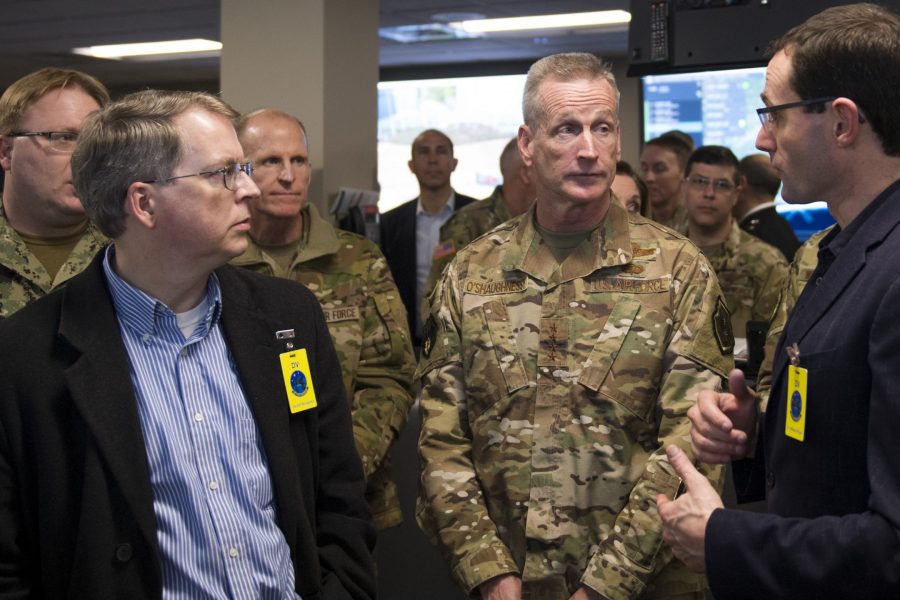A recent Air Force demonstration to share data between USAF and Navy fighter jets, Army munitions, a Navy destroyer, and more proved largely successful, paving the way for a bigger test in April.
Air Force acquisition boss Will Roper and Advanced Battle Management System architect Preston Dunlap told reporters Jan. 21 the service is developing 28 products to collect, analyze, share, and store military data using the cloud. Each is branded with names like “feedONE”—data feeds of government and non-government information—and “omniaONE,” a common operating picture that shows assets across domains like air, space, cyber, land, and sea.
Those came together in the December demo to practice handling threats that US Northern Command faces in real life, like enemy cruise missiles, bombers, and submarines. Twenty-six of the 28 products performed as expected, Roper said.
When done right, the Air Force believes these new battle management improvements—powered by artificial intelligence—can help it wage war faster, smarter, and without hitting classification or service-specific stovepipes that can hinder joint operations now.
“We did begin to pass data back and forth over what we call a low probability of detection intercept, communications link between … Navy and Air Force F-22s and F-35s” using a new gateway built by Northrop Grumman, Lockheed Martin, and Honeywell, Dunlap said.
The service also pulled in its “Global Lightning” program, which proved out the ability to use commercial Internet from SpaceX satellites while aboard an AC-130; used a cloud-based command-and-control and situational awareness application for the first time; and tried out managing the battlespace from a tent instead of a typical brick-and-mortar facility.
One aspect was particularly eye-opening, Roper said: NORTHCOM boss Gen. Terrence O’Shaughnessy and Deputy Secretary of Defense David Norquist worked through the sequence of phone calls that would need to happen to make decisions in a crisis. A new networked approach could turn that on its head.
“The idea with the Advanced Battle Management System is that the people are no longer the glue. The information flows everywhere all at once,” Roper said. “The people are the assessors, the analyzers, the feedback providers that help the analytics … get better and better.”
Some ideas didn’t turn out as well. Robotic guard dogs from US Special Operations Command couldn’t connect to the network, and human special operators had a hard time linking their own camera feeds to the rest of the experiment.
“I hope that we’ll start taking on a little more risk, that we’ll have more things not work, because you learn from that as well,” Roper said. “But for our first demonstration, I’ll take a high success rate.”
Service officials are already considering some tweaks for the next demo. US Space Command and US Strategic Command will join NORTHCOM for the experiment. The gateway, a box equipped with radio antennas that can translate between F-35 and F-22 data languages, sat on the ground for the first test. In April, it will be airborne—possibly on the XQ-58 Valkyrie drone being designed as a fighter jet wingman known as “Skyborg.”
The Air Force plans to hold a test every four months to ensure that the 28 products are developing in ways that work together, not as standalone tools. An industry day is also scheduled for Jan. 29 in Dayton, Ohio, home of Air Force Materiel Command.
Roper and Dunlap see their demonstrations as opportunities for service members to try out new technology and begin to add the upgrades into their systems. Some participants like O’Shaughnessy have already said they want to incorporate certain tools into their own daily operations.
Roper imagines peer pressure could nudge other program offices and operators (not to mention those from the other services and ally and partner countries) to take part in the changes, which at this point are largely piecemeal. The service envisions it could have an initial ABMS network in place by the mid-2030s, and a fuller one in the early 2040s.
“If you put your platform into one of the demonstrations, the thing that we’ll be asking is that … you’re going to follow through on the other side of that and submit your platform to be upgraded with a lot of help from the ABMS pot of funds,” he said. “It’s going to be the competition for those enterprise-wide funds that I think will compel platform owners, the warfighters who own those missions, to take risk, have less readiness, because you’re taking platforms offline to be upgraded—but to get something back that truly is a smart military system.”
